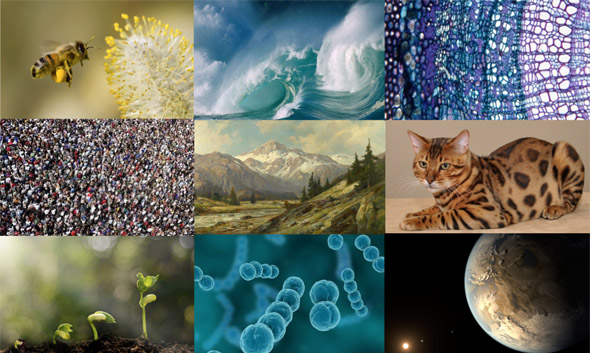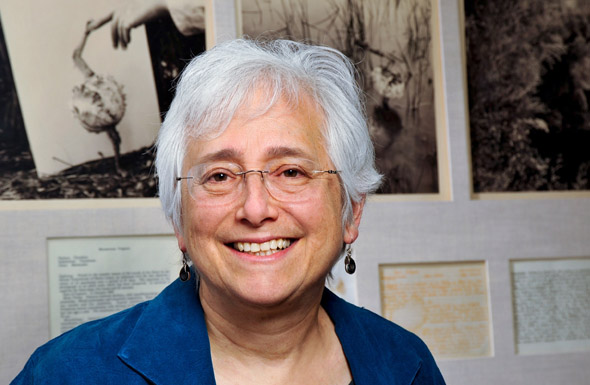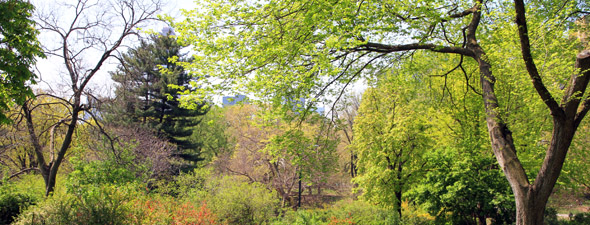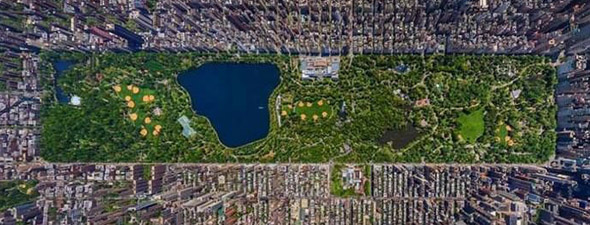What is Wild? 3Q interview with historian Harriet Ritvo
Scientists, social scientists, and humanists heed the Call of the Wild at MIT

"'Wild' is a very powerful category now, as it has been for many centuries. The emotional or ethical response to this power, however, has recently altered. For most of history, to call something "wild" was to express disapproval, but...as wildness has come to seem less threatening and more threatened, people have come to like it better."
What does "wild" mean?
Scientists, social scientists, and humanists tackled this question during "Call of the Wild," a workshop convened at MIT by Harriet Ritvo, Arthur J. Conner Professor of History at MIT, and Sally Shuttleworth, professor of English literature at the University of Oxford. The event was funded by MIT International Science and Technology Initiatives (MISTI) and co-sponsored by Constructing Scientific Communities, a project based at Oxford and supported by the United Kingdom Arts and Humanities Research Council.
In opening remarks, Ritvo observed that the term “wild,” is receiving renewed attention from academics and popular authors alike. Even those who are critical of the term employ it frequently, she said, also noting that most of us are uncertain of the word's conceptual parameters.
Thus, a major goal of the workshop, Ritvo said, was to "tease apart" this ambiguous "multivalent term." In doing so, presentations spanned disciplines from biology to anthropology, astrophysics, and literature, exploring topics such as "Small Beasts: Wildness in the Microbial World," "Bewilderness," "Drawing Boundaries around the Wild," and "Domesticating the Wave." For a full account of all the conference discussions, read the Call of the Wild Workshop Report, prepared by Alison Laurence, a PhD candidate in the HASTS doctoral program (History, Anthropology, and Science, Technology, and Society).
Ritvo teaches courses in British history, environmental history, the history of human-animal relations, and the history of natural history. Her book The Animal Estate, is named as one of the 100 most significant books published by Harvard University Press.
She shared her thoughts recently about the concept "wild" with SHASS Communications.
Q: How can we tell whether or not something is "wild"?
This was the question that provided the underlying structure for the workshop, and there are no definitive answers — this is one reason that the workshop was so interesting.
"Wild" is a very powerful category now, as it has been for many centuries. The emotional or ethical response to this power, however, has recently altered. That is to say, for most of history, to call something "wild" was to express disapproval, but the term has become sufficiently positive for the Shaw's supermarket chain to brand its "organic" product line as "Wild Harvest," described on its website as "created, flavored, and colored by nature." As wildness has come to seem less threatening and more threatened, people have come to like it better.
Can landscapes shaped by human endeavors be considered "wild"?
Even when people agree about whether wildness is good or bad, they have often disagreed about exactly what it is, and about whether an individual organism or group of organisms or even an environment should be described as wild. Sometimes this divergence reflects shifting historical contexts (or lack of historical context). For example, the landscape of the English Lake District has often been characterized as wild, although it is the creation of many generations of sheep and shepherds. Similarly, the first European settlers to arrive in New England perceived the fruitful open woodlands as wild since they were unable to recognize the subtle yet productive management techniques of the people already living there.
The definition of "wild" varies by discipline
Sometimes the definition of "wild" reflects the lenses provided by disciplines. The workshop included participants representing the range of academic disciplines, from literary studies to astrophysics. Presentations focused on animals, plants, microorganisms, as well as the metaphoric extension of wildness to such entities as waves. They explored the reactions of non-specialists as well as of scientists and scholars.
Unsurprisingly, it turns out that deciding whether a fungus is wild or domesticated is a very different process than making an analogous discrimination with regard to a cat. And cheese makers think differently about the wildness of the fungi that transform their milk than do truffle growers about the fungi that they attempt to coax from unpredictably recalcitrant trees. House cats may seem wilder to specialists in animal behavior than they do to historians or pet owners (or the reverse, depending on the cat).

The the term “wild,” is receiving renewed attention from academics and popular authors alike. MIT historian Ritvo notes that even those who are critical of the term employ it frequently, and that most of us remain uncertain of the word's conceptual parameters. Thus, a major goal of the workshop was to "tease apart" this ambiguous "multivalent term."
Q: Do these alternative understandings of wildness have practical consequences?
The stakes involved in receiving (or being denied) designation as "wild" can be very high. Sometimes the rewards are merely economic (for the designators, not those designated). For example, the aesthetic cachet of wildness has inspired the development of domestic cat breeds that include small wild cats among their relatively distant forebears (thus the Savannah cat has the African serval in its family tree). Such breeds are much more expensive than breeds with no claims to exotic extraction or cats of no particular breed.
The impact of having "wild" or "wildnerness" status can be signifcant
But often being recognized as "wild" has farther-reaching consequences, especially in the realms of environmental conservation and species protection. It is much easier to garner political and financial support for the preservation of a landscape if it is described as "wild" or "virgin" or "pristine," even though most such claims are vulnerable to challenge. This is one reason that the national park movement in the United States and many other places (although not in Europe) began by trying to erase the signs of previous human occupation.
(Twenty years ago, the environmental historian William Cronon argued against this absolute understanding of "wilderness" in a well-known essay that has remained surprisingly controversial. See "The Trouble with Wilderness, or Getting Back to the Wrong Nature" in William Cronon, ed., Uncommon Ground: Rethinking the Human Place in Nature, 1995.)
Individual species can also be held to very demanding standards of purity. If their descent is suspected to include significant miscegenation, they can be rejected as candidates for protection or reintroduction. For example, the designation of the red wolf as an endangered species has been entangled with the question of whether it is a pure species or a hybrid of the gray wolf and the coyote.
Is "rewilding" possible?
Similar discussions have swirled around "rewilding" projects — that is, both attempts to re-create vanished (preindustrial and preagricultural) landscapes, such as the Buffalo Commons proposed to replace the most arid portions of the Great Plains, and attempts to resurrect the extinct species that inhabited them, such as the aurochs (the ancestor of all extant domesticated cattle) that once roamed the forests of Europe. Needless to say, such attempts raise a variety of political issues, as well as environmental and economic ones.
Conversations
Excerpts from the Call of the Wild Workshop Report

Is this a wild landscape?
Can we conceptualize wildness outside of the human experience?
"Belknap observes that all the workshop papers have shown how wildness is defined in relation to humans. Would a wildness be less muddled is we remove humans or would it be impossible to define? Similarly Michaela Thompson points out the inherent value judgments related to wild things, like the probiotic bacteria in the human microbiome vs. antibiotic resistant bacteria."
Would the conservation movement have happened without the ambivalent boundary concepts of wildness?
"Ritvo comments that the danger of undue clarity may not be all that pressing. Articles in the Sierra Club magazine, for example, are careful not to describe places as pristine or virgin, but advertisements in that same magazine preserve this problematic language. Both the uncritical and the problematized meanings of wild can operate at the same time."
What does the wild look like?
"Berris Charnley refers to an essay in Uncommon Ground (Anne Whiston Spirn’s “Constructing Nature: The Legacy of Frederick Law Olmsted”) that contrasts the artificiality of Central Park with the fact that most visitors consume it as a natural occurrence. Harriet Ritvo mentions that in her undergraduate environmental history course she shows students an image of Central Park. When asked if it is natural, most students answer affirmatively. But when Ritvo shows them an aerial image of the park, revealing its geometric design, the students question their initial response."

What about this landscape? (Previous photograph is of Strawberry Fields, a section of NYC's Central Park, seen here in an aerial view.)
Q: Are such terms as "invasive species" useful in light of the broad spectrum of biological change that occurs continuously, with or without human engagement?
Perhaps because being recognized as wild can have such significant consequences, various gatekeeping designations have emerged. That is to say, people have tried to erect barriers to restrict the designation of wildness to animals (or other organisms) found worthy. In addition to demonstrating unsullied descent, protected species need to be perceived as indigenous or native. (This requirement reflects the relative brevity of human historical imagination — or the sense that "wild" or "natural" ecosystems are somehow static — in either case, a reluctance to recognize that all terrestrial and marine environments have experienced radical change.)
The ambiguities of "invasive" and "feral"
The term "invasive" also tends to obscure the extent to which humans bear responsibility for the intrusive presence of such organisms. Thus the Australian brushtail possum is persecuted as invasive in New Zealand, where it was introduced over a century and a half ago in an attempt to establish a fur industry. The lionfish that have become common in the Caribbean were brought to Florida to stock home aquariums; like Japanese knotweed, many plants now targeted for extirpation were introduced to adorn home gardens. Other so-called invasions, such as those of purple loosestrife and zebra mussels, occurred as unintended side effects of global trade.
On the other hand, not being sufficiently or conventionally domesticated can also put organisms at risk. Thus animals who lapse from their domesticated condition can be castigated as "feral" (as, occasionally, can be humans who lapse from their civilized condition). In Australia, the sense of "feral" has shifted to overlap significantly with "invasive," so that the Department of the Environment and Energy includes cane toads and red foxes in that category, along with cats, pigs, and camels who have slipped their chains.
It is interesting that although humans are occasionally willing to castigate each other as "feral" or "wild," we are seldom inclined to characterize our species as "invasive."
Suggested links
"Call of the Wild" workshop report
prepared by Alison Laurence, PhD candidate in History, Anthropology, and Science, Technology, and Society at MIT
Harriet Ritvo
Ritvo teaches courses in British history, environmental history, the history of human-animal relations, and the history of natural history. She is currently working on a book about wildness and domestication, especially with regard to other animals.
News Archive
Ritvo's Animal Estate named one of the 100 most significant books from Harvard University Press
Interview prepared by MIT SHASS Communications
Editorial team: Emily Hiestand and Kathryn O'Neill
Photogragh of Harriet Ritvo by Jon Sachs, MIT SHASS Communications
Collage: SHASS Communications